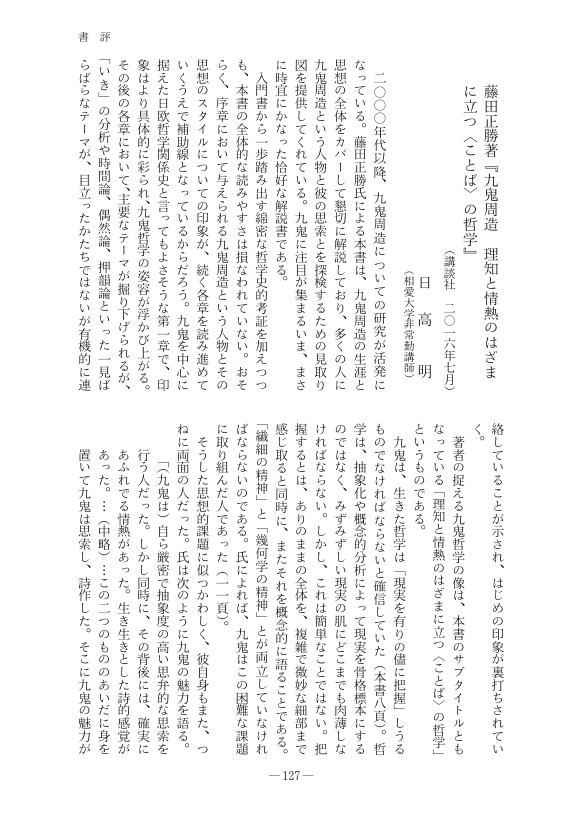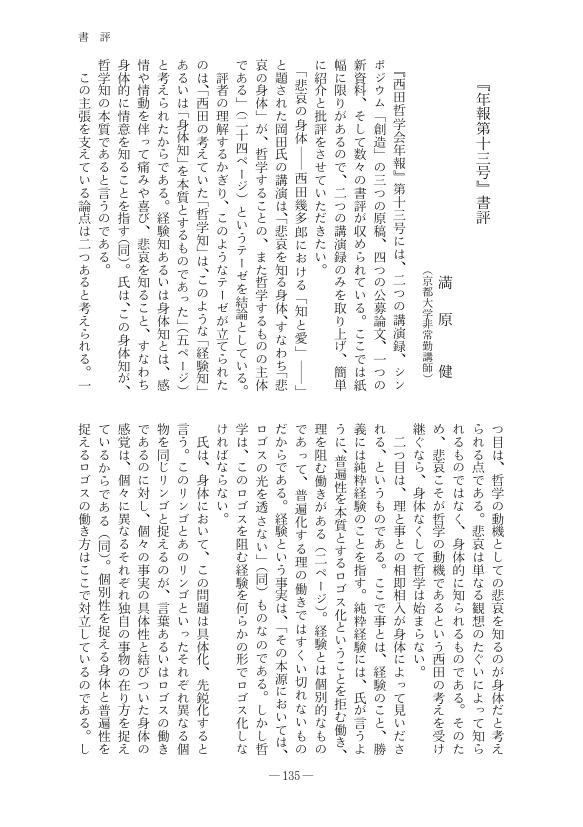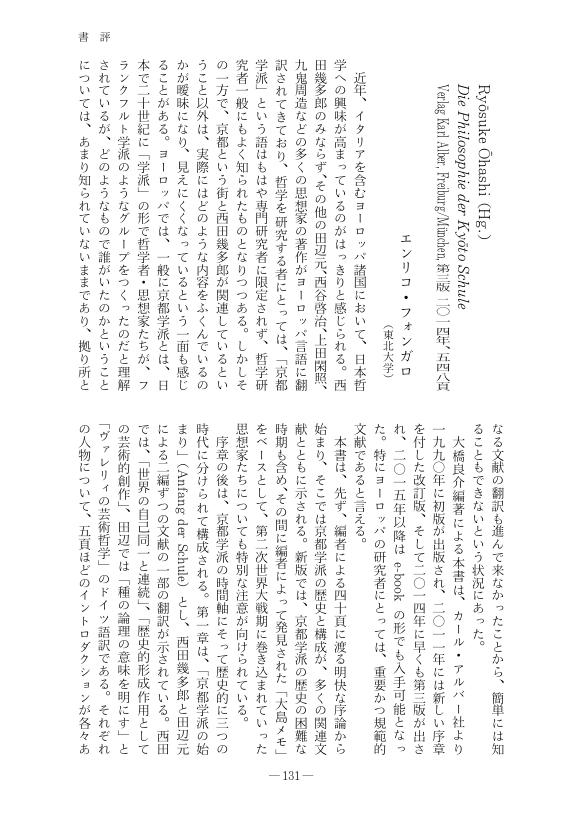1 0 0 0 OA 『年報第十四号』書評
- 著者
- 満原 健
- 出版者
- 西田哲学会
- 雑誌
- 西田哲学会年報 (ISSN:21881995)
- 巻号頁・発行日
- vol.15, pp.185-188, 2018 (Released:2020-01-29)
- 著者
- 竹花 洋祐
- 出版者
- 西田哲学会
- 雑誌
- 西田哲学会年報 (ISSN:21881995)
- 巻号頁・発行日
- vol.16, pp.141-144, 2020 (Released:2020-08-10)
1 0 0 0 OA 哲学の理由 西田幾多郎・「かなしみ」の哲学
- 著者
- 竹内 整一
- 出版者
- 西田哲学会
- 雑誌
- 西田哲学会年報 (ISSN:21881995)
- 巻号頁・発行日
- vol.15, pp.22-39, 2018 (Released:2020-01-29)
Kitaro Nishida declared that, “The motive of philosophy must be the profound sadness of life, rather than surprise. “Kanashimi”(sadness) in Nishida’s thought is a feeling about the self-contradiction of human existence which shapes the life of a mortal being. We can barely connect with others or gods, when we“kanashimu” (grieve) our “kanashimi” (sadness).
- 著者
- 森野 雄介
- 出版者
- 西田哲学会
- 雑誌
- 西田哲学会年報 (ISSN:21881995)
- 巻号頁・発行日
- vol.15, pp.126-141, 2018 (Released:2020-01-29)
This paper focuses on the relation between sensation and the present in Nishida Kitaro’s Intuition and Reflection in Self-awareness(1917). In 1930s, Nishida deepens his metaphysical consideration of the instant present and Nothingness. In this paper, we try to clarify that the discussion in Intuition and Reflection in Self-awareness provides its basis. With regard to the relation of the present and sensation in Intuition and Reflection in Self-awareness, we take a notice of the influence of Hermann Cohen’s epistemology on Nishida’s theory of sensation. Borrowing some concepts, i.e., Ursprung, Erzeugung from Cohen and transforms them to be empirical, Nishida forms his peculiar discussion on the relation between sensation and the bottomless present. Following discussions, namely the production of the ground in the present that affords possibility of rationalization, sensation as a folding of bottomless experience and the differential character of the present formed by the mutual restriction of x and dx, provides the metaphysical basis of Nishida’s discussion after 1930s. This paper clarifies how the foundation of metaphysic for Nishida is established through the elaboration of the concept of sensation in 1917.
1 0 0 0 OA 現代看護学と西田哲学の接点 終末論的思惟
- 著者
- 浅見 洋
- 出版者
- 西田哲学会
- 雑誌
- 西田哲学会年報 (ISSN:21881995)
- 巻号頁・発行日
- vol.15, pp.1-21, 2018 (Released:2020-01-29)
The science of nursing is a practical one. In essence, Nishida’s philosophy could be considered to be the philosophy of religion. Without examination, it does not appear as though there could be a connection between the two. However, end-of-life care in modern nursing science is defined as‘supporting people who are thinking about their inevitable death to enable them to lead the best possible life until they do die’. The basis for this definition is eschatological thought. Furthermore, the final position that Nishida’s philosophy takes is known as‘eschatological thinking Byōjyōtei’. Accordingly, both end-of-life care and Nishida’s philosophy are characterised by eschatological thought. However, their stances on religion are different.
1 0 0 0 OA 〈自覚〉する身体 西田のメーヌ・ド・ビラン評価から見えてくるもの
- 著者
- 杉村 靖彦
- 出版者
- 西田哲学会
- 雑誌
- 西田哲学会年報 (ISSN:21881995)
- 巻号頁・発行日
- vol.15, pp.40-56, 2018 (Released:2020-01-29)
Dans son court écrit de 1936, intitulé «Quelques impressions de la philosophie française», Nishida exprime une sympathie profonde envers «la philosophie du sens intime typiquement française». Malgré la disparité de ses remarques sur ce sujet, la manière dont il s’intéresse à la philosophie française témoigne de ce que sa démarche philosophique «auto-éveillante» partage fondamentalement avec la «philosophie du sentiment» du côté français. Ce qui est particulièrement important est la récurrence des mentions de Nishida sur Maine de Biran, initiateur de la conception originale du «fait primitif du sens intime». Au début des années 1930 où il commence de déplacer l’accent de sa philosophie du néant absolu vers l’idée de corporéité auto-éveillante, Nishida invoque Maine de Biran comme son compagnon de route. Cependant, au dernier moment de cet itinéraire, il se diverge du philosophe français qui tient à l’idée du corps «résistant», idée qui assure la dualité subtile qui s’insère dans le «sentiment de soi» biranien. Comment pourrait-on comprendre la spécificité de la corporéité nishidienne à travers ce processus qui se distingue du biranisme? L’objectif de cette étude consiste à le montrer.
1 0 0 0 OA 後期西田哲学における「行為的直観」と芸術的創作
- 著者
- 大熊 治生
- 出版者
- 西田哲学会
- 雑誌
- 西田哲学会年報 (ISSN:21881995)
- 巻号頁・発行日
- vol.15, pp.94-109, 2018 (Released:2020-01-29)
In the works of Kitaro Nishida,“action”had been the most important concept from his earlier period. In his later period he built up the concept of “active intuition”as the fundamental way of existence. From the concepts “theoria”and“poiesis”of Plotinos, he made up the concept of“intuition”and “action”.“Action”and“intuition”coincide in the Self. To act means to see, i.e. to intuit. So he calls it“active intuition”.“Action”and“intuition”arise from the Body of the Self as the expression of Life. Body means instrument for the acting Self. When the Self works on the outside world, the outside world as the environment defines the Self, mutually. The environment means nature and the society, i.e. the world. The Self, expressing itself, acts on the world, and the world defines the Self. Nishida calls this mutual action or definition between the self and the world“dialectic”. The structure of the world and that of the self is also“dialectic”. Our action as“active intuition” arises from the bottom of the world which defines itself expressively. It is the act of self definition of the historical world. The historical world defines itself by the active intuition.
1 0 0 0 OA 「日本的哲学」の特徴付け 西田幾多郎の思索に沿って
- 著者
- 遊佐 道子
- 出版者
- 西田哲学会
- 雑誌
- 西田哲学会年報 (ISSN:21881995)
- 巻号頁・発行日
- vol.15, pp.71-93, 2018 (Released:2020-01-29)
Following the publication in 2011 of the Japanese Philosophy: A Sourcebook (University of Hawaii Press), the field of Japanese Philosophy is seeing a remarkable global burgeoning. Riding this wave of momentum, The Bloomsbury Research Handbook of Contemporary Japanese Philosophy has just been published in September 2017. The present essay is a continuing reflection of my “Introduction” to this Bloomsbury volume. Therein I originally turned to Nishida’s endeavor as a guide to characterize “Japanese Philosophy.” Nishida’s view of direct experience to be culturally colored led me to unfold my own intercultural reflection on the connection among culture, experience, language, and perception, and I came to realize that the nature of cognition is closely bound up with recognition. I discover that I do not know what I do not hear (especially in reference to things in a different cultural context from my own; a“thing”here is broadly defined, extending from abstract concepts to concrete tangible things). Turning this observation the other way, if I can “hear” a thing in a different culture, I can “know it,” and my knowledge of the thing pushes its existence onto the horizon of my experience. By following Nishida’s philosophical inquiry, I attempted to characterize “Japanese philosophy” with the renewed appreciation of his insight that there is“a logic that is concerned with the workings of the mind, while there is another type of logic that is concerned with the object of consciousness.”
1 0 0 0 OA 鈴木大拙の名号観 一遍から妙好人へ
- 著者
- 末村 正代
- 出版者
- 西田哲学会
- 雑誌
- 西田哲学会年報 (ISSN:21881995)
- 巻号頁・発行日
- vol.15, pp.110-125, 2018 (Released:2020-01-29)
The purpose of this paper is to consider the building process of D.T. Suzuki(1870‒1966)’s Pure Land thought by dividing the process into three parts, that is, one is a period that Suzuki accepted the fundamental Pure Land literature in 1920’s, another is a period that he tried analysis by psychological method in 1930’s and the other is a period that his Pure Land thought developed into his Buddhist philosophy actually in 1940’s. Another purpose is to verify that Suzuki’s Pure Land thought was based on Ippen’s one. Traditional studies didn’t really focus that, but he accepted Ippen in relatively early time. Suzuki was a thinker who emphasized common religious experiences between Zen and Pure Land thought. He focused on Ippen’s thought because it was close to his view of religious experiences. He developed his Pure Land thought through understanding Ippen, especially an immediate integration of sentient beings and dharma. After he accepted Ippen by literature for the first time, he inspected that the case of seeing from psychological aspect, the immediate integration is the same experience as enlightenment in Zen. Suzuki passed through the consideration like this, then established his contradictory logic in 1940’s. It became the inclusive logic that contained his all arguments. Finally, he found Myoko-nin who are firm believers on Shin Buddhism. They were the very people that embodied Suzuki’s thought that had been fostered since adaptation of Pure Land thought.
1 0 0 0 OA 書評 板橋勇仁著『底なき意志の系譜 ― ショーペンハウアーと意志の否定の思想』
- 著者
- 田中 裕
- 出版者
- 西田哲学会
- 雑誌
- 西田哲学会年報 (ISSN:21881995)
- 巻号頁・発行日
- vol.14, pp.123-126, 2017 (Released:2020-03-21)
- 著者
- 水野 友晴
- 出版者
- 西田哲学会
- 雑誌
- 西田哲学会年報 (ISSN:21881995)
- 巻号頁・発行日
- vol.14, pp.100-114, 2017 (Released:2020-03-21)
Nishitani Keiji understood Nishida Philosophy’s core project to be the establishment of new metaphysics. This new metaphysics is characterized by an attempt to lead to transcendental absoluteness without departing from this actual world of ours. This project stems from the modern philosophical circumstances: we are no longer able to find a way to solve the problems of our inner human life by following a path to an other world or, in Buddhist language, the“other side”or“far side”,because, in our modern life, we accept only this world, that is to say,“this side”or“the near side”as the actual and true world and we do not permit any kind of departure from this world. According to Nishitani, Nishida philosophy attempted to solve this problem by breaking through the framework of empiricism to“experience itself”.By means of this breakthrough, we can realize“experience”as the one, whole, and absolute activity. Nishitani understands Nishida’s breakthrough to experience itself as a transcendence to“this side”or“the near side”.By means of this breakthrough, our personal subjectivity will also come to be recognized as a part of the one, whole and absolute activity; and hence a path to absoluteness will be found that differs from the path that leads to a transcendence to an “other side”or“far side”.In this manner, Nishida Philosophy establishes a new metaphysics, which connects us with transcendental absoluteness without departing from our actual and daily world.
1 0 0 0 OA 書評 藤田正勝著『九鬼周造 理知と情熱のはざまに立つ〈ことば〉の哲学』
- 著者
- 日高 明
- 出版者
- 西田哲学会
- 雑誌
- 西田哲学会年報 (ISSN:21881995)
- 巻号頁・発行日
- vol.14, pp.127-130, 2017 (Released:2020-03-21)
1 0 0 0 OA 書評 末木剛博著『日本思想考究 ― 論理と構造』
- 著者
- 竹花 洋佑
- 出版者
- 西田哲学会
- 雑誌
- 西田哲学会年報 (ISSN:21881995)
- 巻号頁・発行日
- vol.14, pp.119-122, 2017 (Released:2020-03-21)
1 0 0 0 OA 『年報第十三号』書評
- 著者
- 満原 健
- 出版者
- 西田哲学会
- 雑誌
- 西田哲学会年報 (ISSN:21881995)
- 巻号頁・発行日
- vol.14, pp.135-138, 2017 (Released:2020-03-21)
1 0 0 0 OA 書評 小坂国継著『近代日本哲学のなかの西田哲学 ― 比較思想的考察』
- 著者
- 井上 克人
- 出版者
- 西田哲学会
- 雑誌
- 西田哲学会年報 (ISSN:21881995)
- 巻号頁・発行日
- vol.14, pp.115-118, 2017 (Released:2020-03-21)
- 著者
- フォンガロ エンリコ
- 出版者
- 西田哲学会
- 雑誌
- 西田哲学会年報 (ISSN:21881995)
- 巻号頁・発行日
- vol.14, pp.131-134, 2017 (Released:2020-03-21)
- 著者
- トランブレー ジャサント
- 出版者
- 西田哲学会
- 雑誌
- 西田哲学会年報 (ISSN:21881995)
- 巻号頁・発行日
- vol.14, pp.171-145, 2017 (Released:2020-03-21)
1 0 0 0 OA 「無からの創造」と「潜在からの顕現」との両否定 西田とヘーゲル
- 著者
- 熊谷 征一郎
- 出版者
- 西田哲学会
- 雑誌
- 西田哲学会年報 (ISSN:21881995)
- 巻号頁・発行日
- vol.14, pp.85-99, 2017 (Released:2020-03-21)
Both Nishida and Hegel see the occurrence of something from the viewpoint of‘energeia and dynamis’.In this paper, we try to clarify their theory and consider their relation and difference. Hegel generally sees the occurrence of something as change from energeia to dynamis. He thinks our activity derives something which exists in itself from condition. In A Study of Good, Nishida sees product of act as actualization of potential inspiration and formulates form of activity of consciousness as differentiation and development of potential totality. We can see Hegel’s influence on Nishida’s thought above. However, after the book, we can see change in Nishida’s thought. That is to say, in the later Nishida, he negates either actualization of potentiality or creation from nothing and consists paradox that something comes from the former world spontaneously while activity of finding it out changes it. Hegel’s theory has tendency of a kind of determinism. On the other hand, Nishida’s theory permits various possibilities of new occurrence and allows creativity and individuality of our activity which takes part in determination of new occurrence. As for our action, Hegel sees it as actualization of our potential talent and character and as change of form from dynamis to energeia whereas Nishida thinks that product of act cultivates our talent and character.
1 0 0 0 OA 閉じた個という不合理 フッサールと西田における他性の謎
- 著者
- 田口 茂
- 出版者
- 西田哲学会
- 雑誌
- 西田哲学会年報 (ISSN:21881995)
- 巻号頁・発行日
- vol.14, pp.34-50, 2017 (Released:2020-03-21)
We often think of consciousness as if it were a capsule surrounded by a boundary. In this paper, I will show in a phenomenological way that such an image of consciousness does not match the reality given to us. In fact, we cannot find any borderline of our own consciousness. This peculiarity of consciousness makes it difficult to understand how we can experience the otherness of the other. How can there be any otherness if there are no boundaries between consciousnesses? I shall make clear how Husserl and Nishida struggled with this fundamental problem. First, I interpret the “unbounded”character of consciousness as“non-contexutuality”.On the basis of this discussion, I present the basic question concerning the other experienced in consciousness. Second, I examine how Husserl addressed this question. The early Husserl tried to deal with this problem on the basis of his idea of“pure consciousness”which was construed as something “indefinite”.The collapse of this idea motivated Husserl to develop his later concept of“primal I”(Ur-Ich). Third, I discuss how Nishida dealt with the same question. After he tackled this problem in his early theory of“pure experience”,he would overcome this attempt in his later article“I and Thou”,which seems to stress the non-contextual encounter with otherness.
1 0 0 0 OA 西田哲学から聖霊神学へ トポロギー神学の成立をめぐって
- 著者
- 小野寺 功
- 出版者
- 西田哲学会
- 雑誌
- 西田哲学会年報 (ISSN:21881995)
- 巻号頁・発行日
- vol.14, pp.17-33, 2017 (Released:2020-03-21)
The author’s main concern in pursuing problems in philosophy has so far been with a possibility of establishment of a Christian theology, uniquely Japanese, with full comprehesion of Japanese spirituality, partially revealed by the logical steps taken by Nishida Kitaro in his philosophical studies. The result has been the author’s conclusion that there exists the royal road from Nishida’s philosophy to the theology of Holy Spirit, and that a passageway to the new philosophy should lie in systematic formation of the topological theology of Holy Trinity. In addition, the Christian faith, logically backed up by this theology of Holy Spirit, should not only bring itself into close contact with the philosophy of Japanese spirituality advanced by Suzuki Daisetsu but help to start a kind of religious revolution: something globally and universally awaited in this new century. Only in this direction is Nishida’s philosophy expected to be genuinely deepened and developed by his disciples. These are some of the conclusions that the author has reached at the end of his nearly livelong inquiry into these important philosophical and religious problems.








